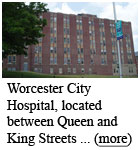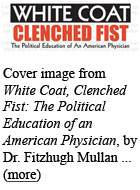Fighting City Hall: The People's Medicine in Action
Considering that engagement with one's community was one of the core commitments of Family Medicine as a discipline, it will be no surprise that the Worcester residency was soon caught up in the struggle for quality health care for the urban poor. Its home base, Worcester City Hospital, was a popularly esteemed, but old and decrepit, institution in the city's poorest neighborhood. Owned by the city of Worcester, City Hospital's superintendent, Paul Murphy, reported to City Manager Francis McGrath's office and was in no position to make large financial commitments on his own. Unhappily, by the mid-1970s Worcester was in steep economic decline with empty lots and deserted factories lining downtown streets, while oil prices climbed and stagflation unsettled the economy. Stephen Earls remembered City Hospital as
…quite a place. Being a city hospital, [it] never had enough funding. Staffing wasn't always ideal, and facilities were way less than ideal. There was an old ward there that must have had 10 or 12 beds in it, it was just this long ward with beds lined up against the wall and curtains between them. [It] was a horrible environment in which to take care of patients—I mean, talk about HIPAA—you couldn't have any conversation with anybody in there that was private. That was a tough place to work.
 The hospital was one of many municipal hospitals to be caught in an economic undertow during these decades, as inner cities,
previously the location of choice for teaching hospitals, confronted the effects of their neighborhoods' downward mobility. In
Worcester, however, Main South had been a relatively impoverished neighborhood for decades, since it had been a "first destination" for
earlier immigrant groups. Those earlier immigrants (or their children) had moved on to better housing by the 1960s, but their
socio-demographic niche was replaced mainly by emigrants from Puerto Rico and Latin America as well as a small proportion of African
Americans and elderly holdouts from the earlier influx. Not surprisingly, linguistic, cultural and racial differences contributed to the
difficulty of advocating for the neighborhood with City Hall.(84)
The hospital was one of many municipal hospitals to be caught in an economic undertow during these decades, as inner cities,
previously the location of choice for teaching hospitals, confronted the effects of their neighborhoods' downward mobility. In
Worcester, however, Main South had been a relatively impoverished neighborhood for decades, since it had been a "first destination" for
earlier immigrant groups. Those earlier immigrants (or their children) had moved on to better housing by the 1960s, but their
socio-demographic niche was replaced mainly by emigrants from Puerto Rico and Latin America as well as a small proportion of African
Americans and elderly holdouts from the earlier influx. Not surprisingly, linguistic, cultural and racial differences contributed to the
difficulty of advocating for the neighborhood with City Hall.(84)
Many urban residencies at the time were filled with men and women who had spent their years in medical school during the mid-to-late
 1960s participating in social protest movements and institutional consciousness-raising. Such students engaged in concerted attempts to
bring more social awareness into medical school curricula, into the
priorities of the AMA, and into their own lives through activist
groups such as the Medical Committee for Human Rights and the various chapters of the Student Health Organization (SHO). The anti-war
and civil rights movements, followed by the women's rights movement left a mark on these young physicians. The SHO, for example, began
in 1964 at the University of Southern California and quickly was replicated at other medical schools where med students organized
community health, vaccination, family planning, and other such clinics in low income and ethnically or racially segregated
neighborhoods.(85)
1960s participating in social protest movements and institutional consciousness-raising. Such students engaged in concerted attempts to
bring more social awareness into medical school curricula, into the
priorities of the AMA, and into their own lives through activist
groups such as the Medical Committee for Human Rights and the various chapters of the Student Health Organization (SHO). The anti-war
and civil rights movements, followed by the women's rights movement left a mark on these young physicians. The SHO, for example, began
in 1964 at the University of Southern California and quickly was replicated at other medical schools where med students organized
community health, vaccination, family planning, and other such clinics in low income and ethnically or racially segregated
neighborhoods.(85)
Residents, too, were caught up in the political intensity of the era. The Committee of Interns and Residents (CIR), for example, formed in New York City in 1957 to push for improved conditions for residents and patients in the municipal hospitals of New York City. In 1958 it was recognized by the New York City municipal hospitals as the bargaining agent for "City-paid house staff." Few (or no) other residents' groups followed their lead until, in 1964, residents at UCLA tried to organize. In 1965, more than ninety percent of the residents at Boston City Hospital petitioned the mayor to protest the appalling conditions of the hospital. Another residents' protest erupted at George Washington University Hospital in 1969. These disparate actions coalesced into a national movement. In 1972, CIR's legal counsel, labor lawyer Murray Gordon, negotiated a contract with New York's municipal hospitals to improve residents' wages and, more importantly, to reduce the frequency of "on-call" nights, a measure designed to benefit patients as well as residents. By 1975, a year after the National Labor Relations Board ruled that employees of health care organizations were permitted to join collective bargaining organizations, the CIR and other residents' groups around the country voted to join a national organization, the Physicians National House Staff Association. In December 1975, delegates to the PNHA from 108 local house staff associations representing an estimated 19,000 members voted to become a bargaining unit for its membership. Diverse pressures from both the American Hospital Association and the AAMC (which was engaged in a serious effort to professionalize post-graduate medical education), however, influenced the NLRB to reverse itself, now asserting that residents were students, not workers, and thus not entitled to engage in collective bargaining. Although this ruling did not hold for municipal employees, such as those at Boston or Worcester City Hospital, it intensified the sense of grievance felt by many members of the relatively new PNHA.(86)
These events coincided with the proliferation of family medicine residencies, some of whose recruits were those same politicized students who had helped found chapters of the Student Health Organization in medical school. Now they were bringing their commitment to social justice with them. As Lucy Candib told us,
The kind of people who are attracted to be the first resident in a residency program are people who are willing to take chances, people who have some vision of an alternative way of practicing medicine. It was a time of taking risks and doing radical things and working in a community health center, starting a residency, low income people, family practice. It was everything I wanted to do and it was all rolled up in one."(87)
